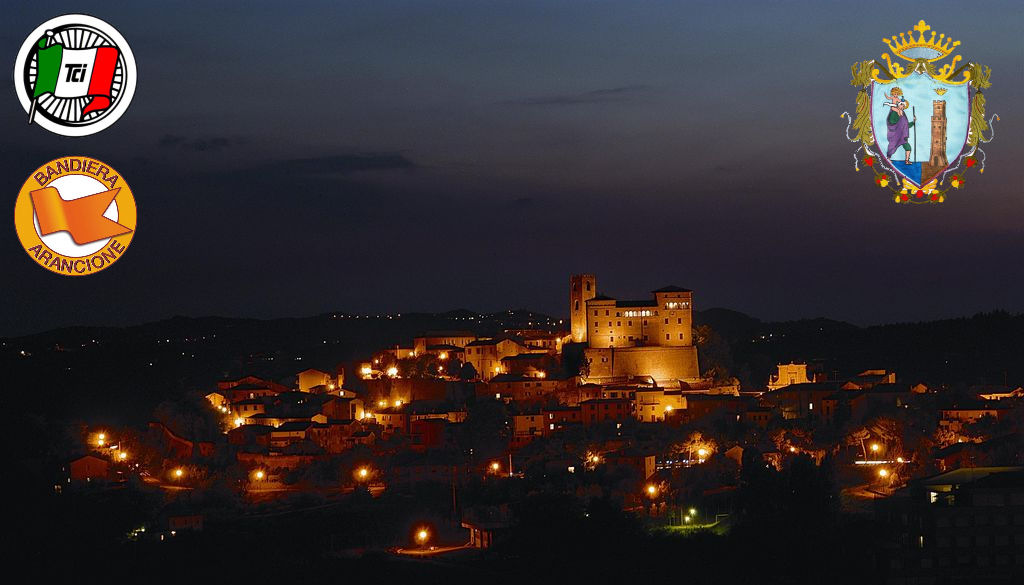Un tranquillo borgo sulle prime colline romagnole, dominato da un castello, con un articolato sistema museale ed un teatro che è un piccolo gioiello. Questo in sintesi è Longiano, Comune che nel 1991 ricevette il premio della rivista Airone “paese dove vivere è bello” e insignito nel 2005 dal Touring Club della bandiera arancione, ambito premio riservato ai borghi e ai Comuni che si distinguono per la qualità del vivere, dell’accoglienza e dell’offerta culturale.
A quiet village on the hills of Romagna, dominated by a castle, with a complex Museum system and a theater that is a little gem.This is in short Longiano, which received in 1991 the prize of the Airone magazine “country where life is beautiful” and awarded in 2005 by the Touring Club of the Orange flag, coveted award reserved for villages and municipalities that stand out for their quality of life, the welcome and cultural offer.
Storicamente i documenti d’archivio citano un castrum a partire dal 1059, anche se probabilmente gli abitanti della pianura si rifugiarono su questa collina molto prima di quella data, per sfuggire alle invasioni barbariche. Per la peculiare e strategica posizione, a metà strada tra Rimini e Cesena, Longiano fu contesa dai signori locali di entrambe le città. Legatasi a Rimini, venne distrutta una prima volta dai Cesenati nel 1198 e, successivamente, nel 1297. Le mura vennero rinforzate in seguito al secondo rovinoso assalto e oggi, nelle maglie concentriche delle fortificazioni del castello, si possono individuare i segni delle ricostruzioni. Conquistata dai Malatesta, ebbe come primo signore Gianciotto, tristemente noto come marito e assassino di Francesca da Rimini e del proprio fratello Paolo “il Bello”.
Longiano diede asilo ad uno dei più importanti personaggi di questa dinastia di bellicosi ma anche illuminati signori: Carlo Malatesta, che morì nel castello longianese nel 1429. Il Papato concesse poi la cittadina in feudo perpetuo ai Rangoni di Modena: in una lapide del castello è ancora leggibile il nome del nobile casato. Seguendo la sorte della maggior parte dei piccoli paesi limitrofi, Longiano venne nel Cinquecento assoggettata al potere diretto della Chiesa, sotto il cui dominio rimase, con le brevi parentesi della conquista veneziana e di quella napoleonica, fino all’Unità d’Italia. Tra Settecento e Ottocento il paese venne abbellito con chiese e palazzi e, nel 1870, con l’inaugurazione del delizioso Teatro Petrella. Gli anni della Seconda Guerra Mondiale hanno inferto gravissimi danni a Longiano, distruggendo una buona parte del borgo, successivamente ricostruito. Di questo triste periodo restano tracce nel rifugio bellico anti-aereo che attraversa ancora oggi la collina, proprio sotto il castello. A partire dagli anni Novanta Longiano si è contraddistinta per importanti investimenti nel settore culturale: nel 1986 è stato riaperto il Teatro Petrella, dopo anni di abbandono, sono state ristrutturate le chiese del borgo e l’ex convento dei Gerolomini, che è oggi sede di importanti istituzioni culturali.
Historically, the archival documents have mentioned a castrum since 1059, though probably the inhabitants of the Plains took refuge on this Hill long before that date, to escape the barbaric invasions.
For the peculiar and strategic location, halfway between Rimini and Cesena, Longiano was disputed by local lords of both cities. Being attached to Rimini, was destroyed the first time by the Cesenatics in 1198 and, later, in 1297. The walls were reinforced after the second devastating assault and today, concentric in the mesh of the fortifications of the Castle, you can detect signs of rebuilding. Conquered by the Malatestas, it had as its first Lord Gianciotto, infamous as husband and Francesca da Rimini’s killer so as his brother’s, Paul “the Handsome”. Longiano gave asylum to one of the most important figures of this warlike dynasty but also made of enlightened gentlemen: Carlo Malatesta, who died in the Longiano Castle in 1429. The papacy conceded then the town in perpetual fiefdom to Rangonis of Modena: the name of the noble House is still legible on a stone of the castle.
Following the fate of most neighboring villages, Longiano was in the sixteenth century subject to the direct authority of the Church, under whose Dominion remained, with the short period of the conquest of Venice and the Napoleonic wars, until the unification of Italy. Between the eighteenth and nineteenth centuries the country was adorned with churches and palaces and, in 1870, with the inauguration of the delightful Teatro Petrella. The years of World War II caused serious damage to Longiano, destroying a good part of the village, subsequently rebuilt. This sad period has left traces: an air-raid shelter which still crosses the Hill, just below the castle. Since the 1990s Longiano has been investing in the cultural sector: in 1986 was reopened the Teatro Petrella, after years of neglect, the churches of the village have been renovated and the former monastery of Gerolomini is today home to important cultural institutions.
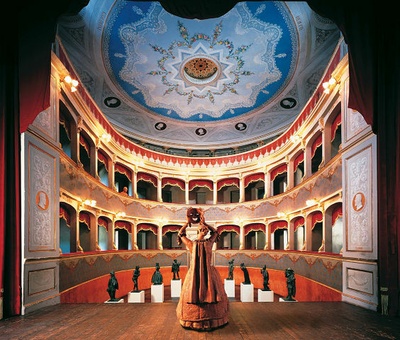
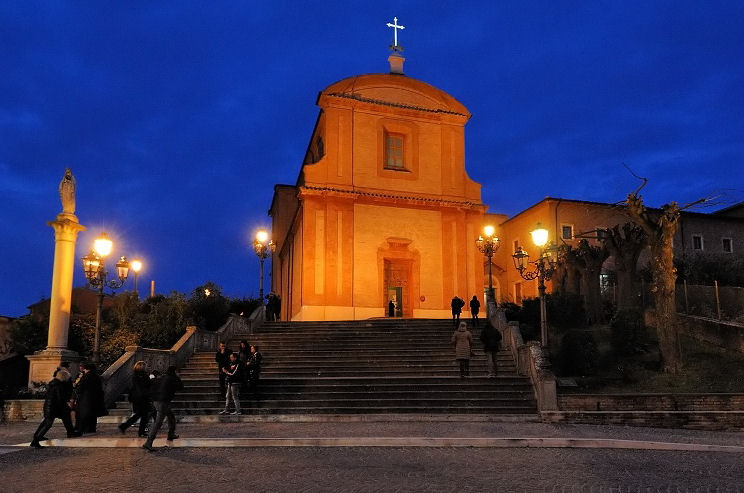
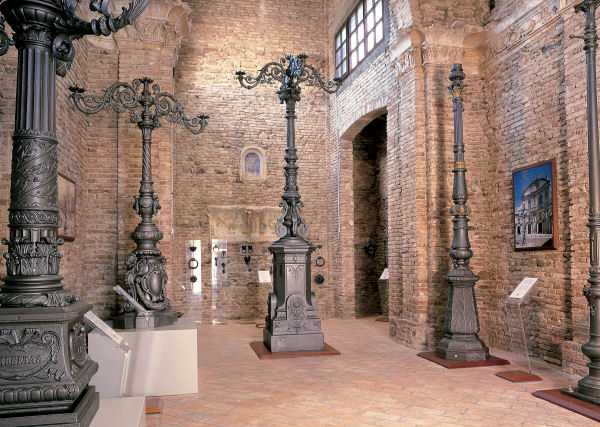
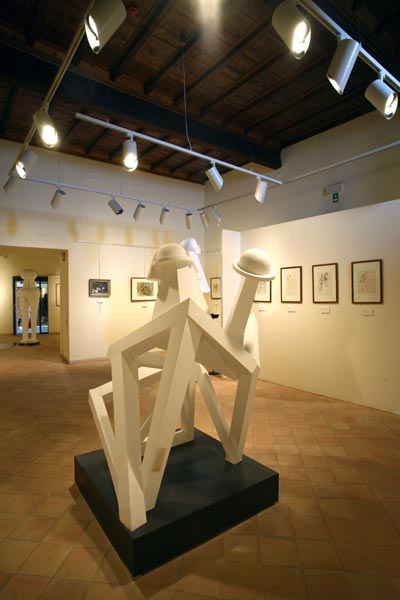
COSA VEDERE
Il Castello Malatestiano è sede dell’importante Fondazione Tito Balestra, museo di arte contemporanea tra i più interessanti della Regione Emilia Romagna. Il Museo di Arte Sacra è una collezione di arredi liturgici situata all’interno dello straordinario contenitore in stile tardo barocco della Chiesa di S. Giuseppe, illuminata da stucchi di fine Settecento. Il Museo Italiano della Ghisa, nella ex chiesa di Santa Maria delle Lacrime, ospita la mostra permanete dedicata all’arredo urbano in ghisa. Il Museo delle Maschere, allestito nelle sale dell’ex Convento dei Gerolomini, racconta la tradizione italiana della Commedia dell’arte attraverso una serie di sculture in bronzo. Il Santuario del SS. Crocifisso, settecentesco, ospita un Crocifisso di scuola giuntesca (XIII sec.), oggetto di una sentita devozione. La Collegiata di S. Cristoforo custodisce alcuni dipinti di grande interesse, come la Crocifissione del Centino. Al centro del paese s’innalza la bella chiesa parrocchiale con uno snello campanile. Conserva al suo interno importanti quadri recentemente restaurati; tra questi la tela raffigurante il Crocifisso con la Madonna e San Giovanni Battista del Centino. Più avanti sorge il teatro comunale «Errico Petrella», dedicato al compositore che l’inaugurò con l’opera «I promessi sposi» il 24 luglio 1870 e che svolge un’apprezzata attività in vari settori dello spettacolo.
WHAT TO SEE
The Malatesta Castle is home to the important Tito Balestra Foundation, Museum of Contemporary Art among the most interesting of the Emilia Romagna region. The Museum of Sacred Art is a collection of liturgical furnishings located within the extraordinary late Baroque style of the Church of St. Giuseppe, lit by end-18th century stuccoes. The Italian Museum of cast iron, in the former Church of Santa Maria delle Lacrime, hosts the permanent exhibition dedicated to the cast-iron street furniture. The Museum, housed in the former convent of Gerolomini, tells the Italian tradition of Commedia dell’Arte with a series of bronze sculptures.
The Sanctuary of SS. Crucifix (18th century), houses a crucifix of giuntesca school (13th c.), subject of a heartfelt devotion. The Collegiate Church of S. Cristoforo holds some paintings of great interest, such as the Crucifixion by Centino.
In the Centre of the village stands the beautiful parish church with a ‘slender’ Bell Tower.
It conserves valuable paintings inside restored recently.
These include the painting of the Crucifixion with the Virgin and St. John the Baptist by Centino. Further on stands the town theatre “Petrella Errico», dedicated to the composer that opened with the opera” I promessi sposi» on July 24, 1870 and which plays a popular activity in various sectors.
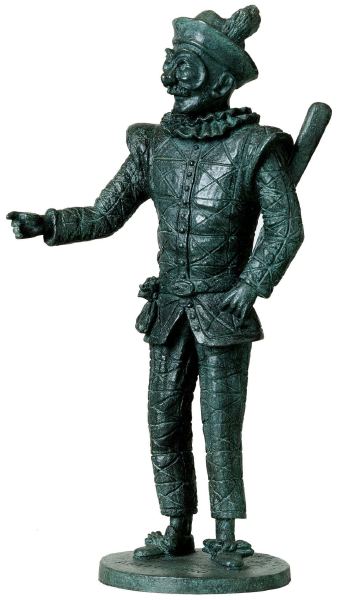
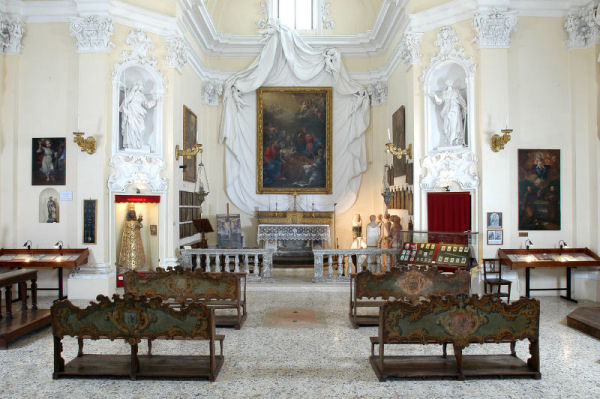
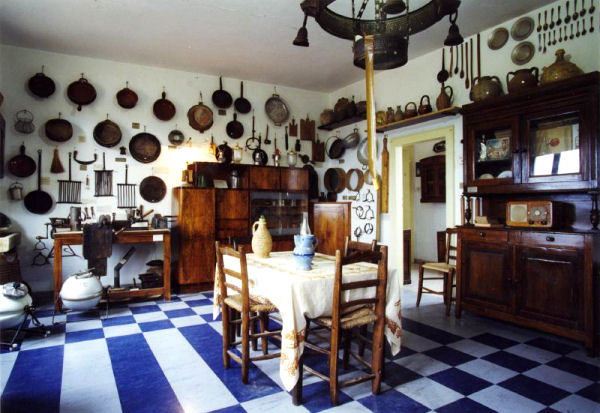
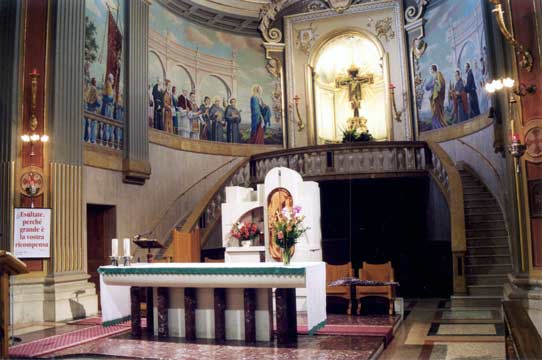
SUGGERIMENTI
Per vivere al meglio l’offerta culturale di Longiano consigliamo di prestare attenzione alle esposizioni ed iniziative proposte dalla Fondazione Balestra, che organizza periodicamente interessanti rassegne dedicate all’arte e alla letteratura contemporanea. Da non tralasciare una visita ad una delle tipiche aziende locali che producono frutta, vino, olio e altre prelibatezze romagnole.
TIPS
To enjoy the cultural offer of Longiano you should pay attention to the exhibitions and initiatives proposed by the Balestra Foundation, which periodically organizes interesting exhibitions devoted to contemporary art and literature.
Not forgetting a visit to one of the typical local companies that produce fruit, wine, olive oil and other table delicacies from Romagna.
